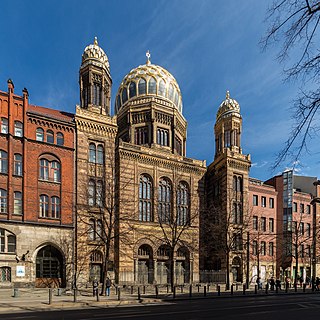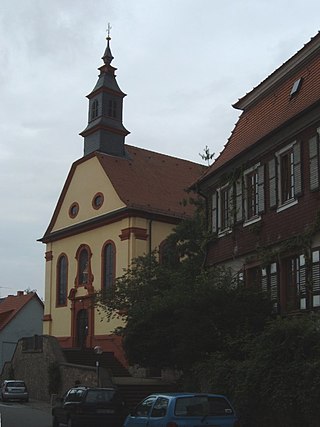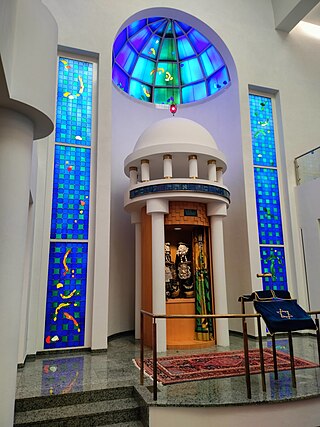
The New Synagogue on Oranienburger Straße in Berlin is a mid-19th century synagogue built as the main place of worship for the city's Jewish community, succeeding the Old Synagogue which the community outgrew. Because of its eastern Moorish style and resemblance to the Alhambra, the New Synagogue is an important architectural monument in Germany.

Hagenow is a German town in the southwest of Mecklenburg-Western Pomerania, in the district of Ludwigslust-Parchim, 30 kilometers south of Schwerin. Its population is approximately 11,300 inhabitants (2013).

The Fasanenstrasse Synagogue was a liberal Jewish synagogue in Berlin, Germany opened on 26 August 1912. It was located in an affluent neighbourhood of Charlottenburg on Fasanenstrasse off Kurfürstendamm at numbers 79–80, close to the Berlin Stadtbahn and Zoo Station.

Hemsbach is a town with approximately 12,000 inhabitants in the Rhein-Neckar-Kreis of Baden-Württemberg, Germany. It belongs to the European Rhine-Neckar Metropolitan Region. It is situated on the Bergstraße, 18 km northeast of Mannheim. Hemsbach was twinned with Wareham, Dorset in the UK in 1986.

The Olomouc Synagogue, located in Olomouc, Czech Republic, was built in 1897 and was destroyed during a Nazi attack in March 1939.

Rykestrasse Synagogue, Germany's largest synagogue, is located in the Prenzlauer Berg neighbourhood in the Pankow borough of Berlin. Johann Hoeniger built the synagogue in 1903/1904. It was inaugurated on 4 September 1904, in time for the holidays of and around Rosh Hashanah. The synagogue stands off the street alignment and is reached by a thoroughfare in the pertaining front building.

The Alte Synagoge in Erfurt, Germany, is one of the best preserved medieval synagogues in Europe, its oldest parts dating back to the late 11th century. Most parts of the building date from around 1250–1320. Due to the fact that its roof is still standing, it is thought to be the oldest synagogue building intact in Europe and the world.

Neumarkt is a street and a historical area in the Rathaus quarter (Altstadt) of Zürich, Switzerland.
Elias Hößler was from Saxony originally, active in the Upper Palatinate and Franconia as a pipe organ builder.

The Synagoge Zürich Löwenstrasse is the oldest and largest synagogue in the Swiss municipality of Zürich. In 1884 built in Moorish style, the oldest synagogue of Zürich also houses the prayer and school house of Israelitische Cultusgemeinde Zürich (ICZ) which was founded in 1862. ICZ is a unified Jewish community having about 2,500 members, and thus the largest Jewish community in Switzerland, which since 2007 in the Canton of Zürich is recognized as a denomination, i.e. it has the same legal state as the Christian denominations. In the synagogue, the community celebrates the daily Minyan and Shabbat and holiday services. The synagogue is a cultural heritage of national importance in Switzerland.

Israelitische Cultusgemeinde Zürich, commonly shortened to ICZ, is a united Jewish community in the Swiss city of Zürich. Consisting of about 2,500 members, the ICZ is the largest Jewish community in Switzerland. The community has a Synagogue in Löwenstrasse in Zürich-City, a community center with a kindergarten and Jewish library in Zürich-Enge, and two cemeteries.

The old Rottweil Synagogue is a synagogue in Rottweil in Baden-Württemberg. It was established in 1861. The desecrated Synagogue is located in Kameralamtsgasse 6, former Judengasse, close to Kapellenkirche and next to Bischöfliches Konvikt and gymnasium. The construction of a new synagogue in Rottweil began in March 2016.

Alfred Jacoby is a German architect and architectural lecturer, principally known for his output of synagogues in post-war Germany, development of a modern Jewish religious architectural vernacular, his teaching positions as a lecturer and professor of architecture, and his active architectural practice in Frankfurt am Main. Jacoby was born in Offenbach, in 1950, to a Polish father, and was educated at the University of Cambridge and Eidgenössische Technische Hochschule. Credited with being the first postwar architect in Germany to develop a distinctive Jewish vernacular for synagogue buildings, he is recognised as Germany's leading synagogue architect. Jacoby was Director of the Dessau Institute of Architecture at the Anhalt University of Applied Sciences, Bauhaus Dessau, from 2000 until 2017.

The Neue Synagoge is the synagogue, community centre, and museum of the Jewish community in Darmstadt. Inaugurated on in 1988, the synagogue was built as part of a citizens’ initiative to commemorate the 50th anniversary of Kristallnacht Known also as the ‘Holocaust Memorial Synagogue’, the architectural complex was designed to fulfil the needs of the city's Jewish population, who had been without a place of worship since the 1938 pogrom when Darmstadt's three synagogues were destroyed. Built according to plans by Alfred Jacoby, with a significant programme of stained glass windows designed by British architectural artist Brian Clarke. The religious and cultural complex is located on the site of the city's former Gestapo headquarters.

The synagogue on Fraenkelufer in Berlin's Kreuzberg district was built as an Orthodox Synagogue between 1913 and 1916 according to plans and under the direction of the master builder of the Jewish Community of Berlin, Alexander Beer. The structure was located on Kottbusser Ufer 48–50, today's Fraenkelufer 10-16. On Kristallnacht, the evening of November 9-10th, 1938, the main building of the synagogue was badly damaged. Further destruction in the following years led to the structures ultimate demolition in 1958/1959 after the end of World War II. Today the surviving outbuilding, previously used for the youth service, has been renovated and is home to a Conservative Synagogue. A complete reconstruction of the main synagogue that was destroyed by the Nazis is being planned for its original location.
Johann Esaias von Seidel was a printer, publisher and publicist in the 19th century who promoted the reforms of Maximilian von Montgelas. He also promoted ecumenism, the concept of unity among different Christian denominations.

The Görlitz Synagogue in Görlitz, Germany was built between 1909 and 1911 in the Art Nouveau style and was the main place of worship for the city's Jewish community. Despite an arson attack, the synagogue was one of the few synagogues in the area to survive Kristallnacht, sustaining only minor damage. The damage could have been greater, but was lessened because the firefighters ignored the orders to let the synagogue burn. With the city's Jewish population depleted, the unused synagogue became a ruin in the following decades. In 1991, a restoration project began which was completed in December 2020. Owing to the COVID-19 pandemic, the opening ceremony was postponed until 2021. The synagogue duly opened on July 12, 2021. On September 12, 2022, a new Magen David was placed on top of the synagogue.
The Sulzbacher Torah is a Torah Scroll from the Synagogue of Sulzbach. It dates from 1792 or 1793 and survived both the Sulzbach town fire of 1822 and the November pogroms. After the fall of National Socialism, it was kept unrecognised in the Torah shrine of the Synagogue of Amberg for over seven decades. After its rediscovery, it was restored and completed on 27 January 2021, following the Day of Remembrance of the Victims of National Socialism ceremony of the German Bundestag in the Devotional Room of the Reichstag Building. Patrons were the representatives of the five permanent constitutional bodies of the Germany.
Charlotte Stein-Pick was a German-Jewish emigrant. Today, her memoirs serve historians as a basis for research in many cases, and excerpts from them are often cited in her own German- but also English-language publications.

Volker Staab is a German architect.



















